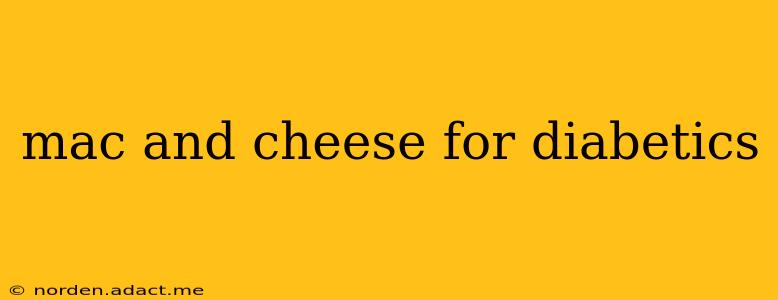Mac and cheese is a comfort food classic, but its high carbohydrate and fat content often makes it a no-go for those managing diabetes. However, with a few smart substitutions and mindful portion control, you can still enjoy this creamy delight without significantly impacting your blood sugar levels. This guide provides delicious and diabetes-friendly mac and cheese recipes and answers common questions about managing this beloved dish within a diabetic diet.
Is Mac and Cheese Okay for Diabetics?
The answer is a nuanced "it depends." Traditional mac and cheese is loaded with refined carbohydrates from pasta and cheese, leading to rapid spikes in blood sugar. However, by making informed choices about ingredients and preparation, you can create a much healthier version. The key is to focus on minimizing refined carbohydrates and maximizing fiber and protein content.
What Makes Mac and Cheese Unhealthy for Diabetics?
The primary culprits are:
- Refined Carbohydrates: Regular pasta is high in glycemic index (GI), meaning it causes a quick and substantial rise in blood sugar.
- High Fat Content: The cheese sauce is often rich in saturated fat, which, while not directly impacting blood sugar, can contribute to other health concerns for diabetics.
- Lack of Fiber and Protein: Traditional recipes lack the fiber and protein that help slow down carbohydrate absorption and stabilize blood sugar.
How to Make Mac and Cheese Diabetic-Friendly?
Several strategies can transform this comfort food into a diabetes-friendly meal:
- Choose the Right Pasta: Opt for whole-wheat pasta, lentil pasta, or shirataki noodles (low-carb option). Whole-wheat pasta has more fiber, slowing digestion and reducing the blood sugar spike. Lentil pasta offers a good source of protein and fiber. Shirataki noodles are virtually carb-free.
- Reduce the Cheese: Use less cheese overall and choose lower-fat cheeses like part-skim mozzarella, reduced-fat cheddar, or even a blend of cheeses to lower the fat content.
- Add Vegetables: Incorporating vegetables like broccoli, cauliflower, or spinach into the cheese sauce adds fiber, vitamins, and nutrients without significantly increasing carbohydrates.
- Boost Protein: Add grilled chicken, chickpeas, or beans for extra protein, which further helps regulate blood sugar levels.
- Control Portions: Even with healthier ingredients, portion control remains crucial. A smaller serving of mac and cheese can still be a satisfying and manageable part of a diabetic meal plan.
Can I Use Cauliflower in Mac and Cheese?
Yes! Cauliflower can be a fantastic low-carb substitute for pasta. You can rice it and use it as a base for your cheese sauce. The cauliflower adds creaminess and a subtle flavor while significantly reducing the carbohydrate count. Many recipes are available online that detail how to create a delicious cauliflower mac and cheese.
What are the Best Cheeses for Diabetic Mac and Cheese?
Lower-fat cheese options are best, including:
- Part-skim mozzarella: Offers a milder flavor and lower fat content compared to full-fat mozzarella.
- Reduced-fat cheddar: Provides a sharp flavor with less saturated fat.
- Greek yogurt: Can be added to the sauce to increase creaminess and reduce the overall amount of cheese needed.
What is the Glycemic Index of Mac and Cheese?
The glycemic index (GI) of mac and cheese varies significantly depending on the ingredients. Traditional mac and cheese made with regular pasta and full-fat cheese has a high GI, causing a rapid blood sugar increase. However, a diabetic-friendly version made with whole-wheat pasta, reduced-fat cheese, and added vegetables will have a significantly lower GI.
How Many Carbs are in Diabetic Mac and Cheese?
The carbohydrate content also depends greatly on the recipe. A traditional serving can easily contain 50-70 grams of carbohydrates or more. A diabetic-friendly version, however, could contain as little as 20-30 grams depending on the portion size and ingredients used. Always check the nutritional information of your chosen ingredients to calculate the total carbohydrate count for your specific recipe.
By following these guidelines and experimenting with different ingredients, you can enjoy a delicious and manageable version of mac and cheese as part of a well-balanced diabetic diet. Remember to consult with your doctor or a registered dietitian for personalized dietary advice tailored to your specific needs and health condition.
